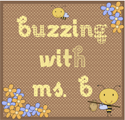I know what you are all thinking....wasn't this week supposed to end on July 1st? Yes, you are correct....but when Jenny emailed me asking if she could still contribute, I just couldn't resist extending this week of learning for one more day! I am so glad I did, because she has some great ideas to share about teaching vocabulary that as she so nicely states- will not only benefit our language learners, but all students!
Hi everyone! I'm Jenny from
Luckeyfrog's Lilypad. I taught 2 years as a 2nd grade interventionist in a low-income school, I've taught 1 year in my own 2nd grade room at a very diverse school, and I'll be staying here to teach 3rd grade next year. I'm still pretty new to teaching and LOVE teaching science more than anything!
When I was in 7th grade, I had an amazing Spanish teacher. He was the teacher who truly made me enjoy learning Spanish, and I still like it, despite a couple of truly awful Spanish classes since trying to take that away from me!
At the time, he was using something he called TPR- he described it to us because he knew that we would struggle at first, but he also knew it was worthwhile. I distinctly remember learning motions to go along with words, and then including the words in a story that we would re-tell in English and Spanish in different tenses all week.
Well, once I was teaching, I figured that if it helped me learn unfamiliar words, some aspects of it would help my students learn unfamiliar words (ELL or not!).
See, here's the secret I learned from our ESL coordinator at my last district...
Almost
all kids benefit from so-called "ESL Strategies."
Particularly there, in a very low-income school-
so many of our students had small vocabularies.
Every week last year, our story came with vocabulary words. In my new series this year, it will come with "Robust Vocabulary." In my previous school, it was through the Beck Vocabulary program (LOVE!). It would be perfect for during Expanding Vocabulary in CAFE. The point is... you can use this in any school, with any basal- and it won't take you as long as you think.
I have a vocabulary routine that I use most weeks.
Monday- introduce the words and definitions, and let students come up with a motion for each. (For instance, "relieved"- deep breath in, and out with the back of your hand crossing your forehead)
Tuesday- Answer a question that uses the word.
Wednesday- Interactive- act out or draw the word in partners, in groups, one in front of the class, etc.
Thursday- Identify the part of speech (if we've learned it), and use the word in a sentence. Have a few share out loud, and then everyone shares with a partner or in Inside-Outside circle.
Friday- Define the words in their own words, and assess with a cloze activity or quiz.
Every day we do motions for the words. On Fridays, I'll often see kids do the motions to themselves during assessments. At the end of every 6 week unit, at least, we'd review ALL of the vocabulary from the unit- and they would remember almost all of it. I really think the motions were a huge part of that!
Vocabulary only takes us about 15 minutes,
tops, every day. I also super encourage them to use and find the words, so I see a lot of kids running up to me with a book, saying, "I found the word relieved!!!" even weeks or months after we've learned that word.
This year, I want to encourage that even more, so I'm planning to make a Vivid Vocabulary Vine.
I plan on hanging this sign above it in my room- hop on over to
Luckeyfrog's Lilypad if you'd like to find out more and get a free copy of the sign! (Bonus: If you follow me, you can see pictures of mine when it's done!)
Thank you, Krista, for letting me guest blog for you today!
What activities do YOU do to help your students internalize new vocabulary?

